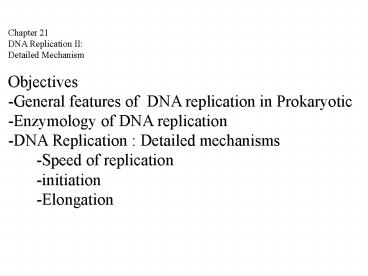DNA Replication II: - PowerPoint PPT Presentation
Title:
DNA Replication II:
Description:
Chapter 21 DNA Replication II: Detailed Mechanism Objectives-General features of DNA replication in Prokaryotic-Enzymology of DNA replication-DNA Replication ... – PowerPoint PPT presentation
Number of Views:98
Avg rating:3.0/5.0
Title: DNA Replication II:
1
Chapter 21 DNA Replication II Detailed
Mechanism Objectives -General features of DNA
replication in Prokaryotic -Enzymology of DNA
replication -DNA Replication Detailed
mechanisms -Speed of replication
-initiation -Elongation
2
(No Transcript)
3
(No Transcript)
4
Speed of Replication The pol III holoenzyme
synthesizes DNA at the rate of about 730 nt/sec
in vitro The rate in vivo is almost 1000
nt/sec This enzyme is highly processive both
in vitro and in vivo
5
21.1 Initiation Initiation of DNA replication
means primer synthesis Different organisms use
different mechanisms to make primers Different
phages infect E. coli using quite different
primer synthesis strategies Coliphages were
convenient tools to probe DNA replication as they
are so simple they must rely primarily on host
proteins to
6
Origin of Replication in E. coli Primosome
assembly at oriC occurs as follows DnaA binds
to oriC at sites called dnaA boxes and cooperates
with DNA polymerase and HU protein in melting a
DNA region adjacent to leftmost dnaA box DnaB
binds to the open complex and facilitates binding
of primase to complete the primosome primes
Okazaki fragment synthesis on lagging strand
DnaB has a helicase activity that unwinds DNA as
the replisome progresse
7
Priming in E. coli Primosome refers to
collection of proteins needed to make primers for
a given replicating DNA Primer synthesis in E.
coli requires a primosome composed DNA
helicase DnaB Primase, DnaG Primosome
assembly at the origin of replication, oriC uses
multi-step sequence
8
(No Transcript)
9
(No Transcript)
10
(No Transcript)
11
(No Transcript)
12
(No Transcript)
13
Summary The yeast Ori contained with
autonomously replicating sequence (ARSs) That
composed of 4 important regions A, B1 ,B2 and
B3 A is 15 bp long( 11 bp consensus conserved
ARSs) B3 allows DNA bending
14
Elongation Once a primer is in place, real
DNA synthesis can begin An elegant method of
coordinating the synthesis of lagging and leading
strands -keep the pol III holoenzyme engaged
with the template Replication can be highly
processive and so very rapid
15
The Pol III Holoenzyme and Processivity of
Replication Pol III core alone is a very poor
polymerase, after assembling 10 nt it falls off
the template Takes about 1 minute to
reassociate with the template and nascent DNA
strand Something is missing from the core
enzyme The agent that confers processivity on
holoenzyme allows it to remain engaged with the
template Processivity agent is a sliding
clamp, the ß- subunit of the holoenzyme































